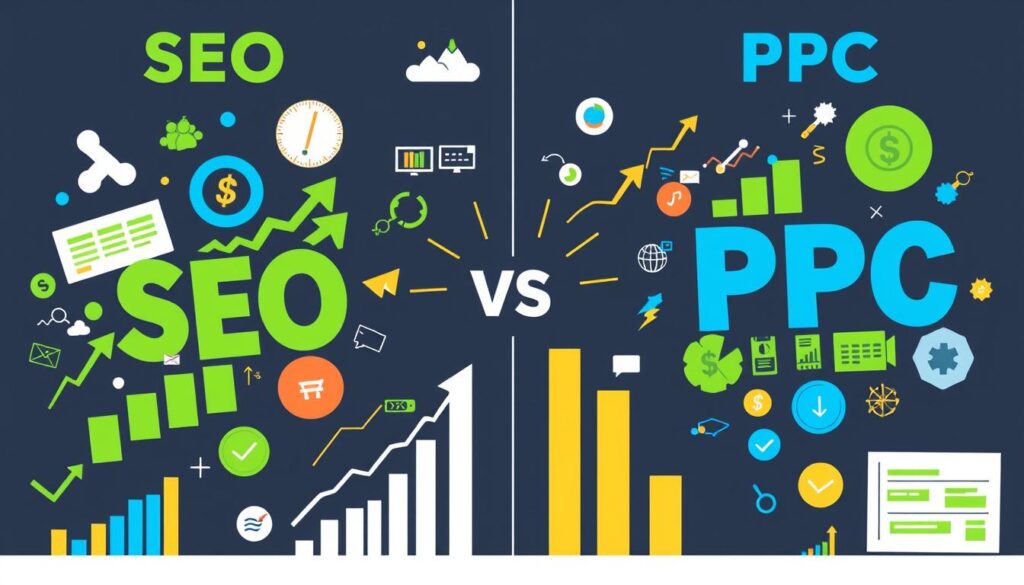In today’s fast-changing digital world, keeping up with search engine optimization (SEO) is key for any business or website. As we move towards 2024, focusing on on-page SEO will be vital. This guide will cover the top on-page SEO techniques and best practices. These can help you make your content, images, and site better for the SERPs (search engine results pages).
Key Takeaways
- Understand the key on-page ranking factors that influence your website’s performance in search.
- Learn effective strategies for conducting keyword research and optimizing your content accordingly.
- Discover best practices for crafting compelling title tags and meta descriptions to improve click-through rates.
- Explore techniques for optimizing images and other multimedia content to enhance user experience and search visibility.
- Gain insights into the importance of content structure, formatting, and internal linking for improved site architecture and crawlability.
What is On-Page SEO?
On-page SEO means making web pages better for search engines and users. It’s about making the content, HTML tags, and site structure more relevant and appealing. This helps the page show up higher in search results.
Definition and Importance
On-page SEO helps web pages rank higher and get more relevant traffic from search engines. It’s key to a good SEO strategy. It tells search engines how to see and rank a website. By using good on-page SEO, businesses can get more online visibility, attract better leads, and increase conversions.
Key On-Page Ranking Factors
Search engines look at these main on-page factors:
- Content quality and relevance – Good content is key for a high search engine ranking.
- Keyword optimization – Using target keywords in the right places can boost search visibility.
- Page structure and formatting – How content is organized affects its search ranking.
- Page speed and mobile-friendliness – Fast-loading, mobile-friendly pages are preferred by search engines.
- Internal linking – How pages link to each other helps search engines understand the site.
By focusing on these on-page factors, businesses can boost their website’s search rankings. This leads to more targeted traffic and helps meet marketing goals.
Keyword Research and Optimization
Effective keyword research is key to successful on-page SEO. It helps you find the right keywords, check their search volume and competition, and use them in your web pages. This makes your content more relevant and can boost your rankings.
Here’s a step-by-step guide to keyword research and optimization for your on-page SEO efforts:
- Brainstorm Relevant Keywords: Start by thinking about what your business offers. List the key terms and phrases your target audience might use to find your content.
- Conduct Keyword Research: Use tools like Google Keyword Planner, Ahrefs, or SEMrush for more keyword ideas. Analyze their search volume, competition, and relevance. This helps you find the best keywords to target.
- Evaluate Keyword Intent: Understand why people are searching for each keyword. Are they looking to buy, find information, or something else? Make sure your content matches their needs.
- Prioritize and Organize Keywords: Group your keywords by relevance and prioritize them. Consider search volume, competition, and how they fit with your business goals.
- Incorporate Keywords Strategically: Once you’ve picked your target keywords, add them to your page titles, meta descriptions, headings, and body content. Don’t overdo it, as too many keywords can hurt your rankings.
By following these steps, you can make your on-page content more relevant and effective. This will help increase your visibility and bring more qualified traffic to your website.
| Keyword | Search Volume | Competition | Relevance |
|---|---|---|---|
| keyword research for seo | 2,400 | High | Very High |
| keyword optimization | 1,900 | Medium | High |
| on-page keyword optimization | 1,300 | Medium | Very High |

Remember, doing good keyword research and optimization is key to making your web pages more visible in search engines. By targeting the right keywords and using them smartly in your content, you can boost your on-page SEO. This will drive more qualified traffic to your website.
Title Tag and Meta Description
The title tag and meta description are key parts of your website’s SEO. They help improve your site’s visibility and get more clicks. Making great titles and descriptions is vital for your SEO strategy.
Crafting Compelling Titles and Descriptions
To make your title tags and meta descriptions stand out, follow these tips:
- Put your target keyword in the title tag and meta description, but don’t overdo it.
- Keep your title tag under 60 characters and your meta description under 160 to show up well in search results.
- Write something that makes people want to click on your link.
- Highlight what makes your page special or its main benefits.
- Use words that make people want to take action, like a call-to-action.
Keyword Placement and Best Practices
Putting your keywords in the right spots in title tags and meta descriptions helps a lot:
- Put your main keyword at the start of the title tag for best results.
- Add other related keywords smoothly into the meta description.
- Avoid using too many keywords, as it can hurt your SEO.
- Make sure your title tag and description are unique and match your page well.
| Element | Best Practices |
|---|---|
| Title Tag |
|
| Meta Description |
|

On-Page SEO
Mastering on-page SEO is key to getting more organic traffic and making your website more visible in search results. This part covers the main on-page SEO tactics and best practices to boost your digital presence. We’ll look at how to make your content, URLs, page speed, and mobile friendliness better for on-page SEO.
Content Optimization
Creating content that’s engaging, relevant, and full of keywords is the base of good on-page SEO. Make sure your content meets what your audience is searching for and uses the right on-page seo keywords smoothly. Use headings, subheadings, and bullet points to make your content easy to read.
URL Structure
Your website’s URL structure is very important for on-page SEO. Choose clean, clear, and keyword-rich URLs that match the page’s content. Avoid long, complex, or off-topic URLs as they can hurt your search engine rankings.
Page Speed Optimization
Page speed is a big deal for on-page SEO because search engines like fast-loading sites. Improve your page speed by compressing images, reducing HTTP requests, and using caching. Check your website’s speed often and adjust as needed for a smooth user experience.
Mobile Responsiveness
With more people using mobile devices, your website must work well on all devices. Make sure your site is mobile-friendly, adjusting to different screen sizes. This makes users happy and helps your on-page seo best practices and mobile search rankings.
| On-Page SEO Checklist | On-Page SEO Techniques | On-Page SEO Best Practices |
|---|---|---|
|
|
|
Using these on-page seo techniques and best practices can greatly improve your website’s on-page SEO. This leads to more organic traffic and better search engine visibility.
Image Optimization
Images are key in making your website better for users and search engines. By optimizing your images, you can boost your site’s performance and visibility. Let’s explore how to make your images work better for SEO.
Alt Text and File Names
Using alt text and descriptive file names is crucial for image optimization. Alt text gives a text description of an image for search engines and screen readers. This helps search engines understand your images better, making them more likely to show up in image searches.
Also, choose file names that clearly describe what’s in the image. Instead of “IMG_12345.jpg”, use something like “product-image-for-seo.jpg”.
Image Compression and Dimensions
Image optimization isn’t just about alt text and file names. The size and dimensions of your images matter too. Big images can make your site slow, hurting your search rankings and user experience.
To fix this, compress your images without losing quality. Tools like image optimization for seo and image compression for seo can help. Also, make sure your images are the right size for your website. This makes your site load faster and improves user experience.
By using these strategies, you can make your website better for SEO and give your visitors a great experience. Aim for images that are both beautiful and fast-loading, making your site more appealing to everyone.
Content Structure and Formatting
Making your web content easy to read and understand can boost its visibility on search engines. Use headings, subheadings, and other formatting to make your content clear and appealing. This approach helps both users and search engines enjoy your content more.
Headings and Subheadings
Using the right HTML tags for headings is key for content structure for SEO. HTML tags like H1, H2, and H3 help organize your content clearly. They make it easy for search engines to understand your content and for readers to find what they need.
- Start with a compelling and descriptive H1 tag to introduce the main topic of your page.
- Use H2 tags to define the primary sections or subtopics within your content.
- Employ H3 tags to further break down your content into more specific subsections, providing additional context and details.
By using these heading optimization methods, your content becomes more structured and SEO-friendly. This makes it easier for users to read and understand, and it can improve your content’s visibility in search results.
Readability and Scanability
Improving your content’s readability and scanability is also important. Break your text into short paragraphs and use bullet points or numbered lists. This makes your content look better and easier to read. It also helps search engines understand your content better.
By focusing on content structure for SEO and using heading optimization and SEO-friendly content formatting, you can make your content more user-friendly. This approach can increase engagement and improve your online visibility.
Internal Linking and Site Architecture
Creating a well-structured website is key for better on-page SEO. By linking your web pages smartly, search engines can understand your content better. This makes your site easier to use and shows search engines how important your pages are.
Having a good site architecture is also important. It means organizing your website in a way that’s easy for everyone to follow. A clear structure helps visitors and search engines find what they need on your site.
Using smart internal linking and site architecture can boost your SEO. By planning and executing these strategies well, you can make your website more visible and trusted. This leads to more visitors and better search engine rankings.


